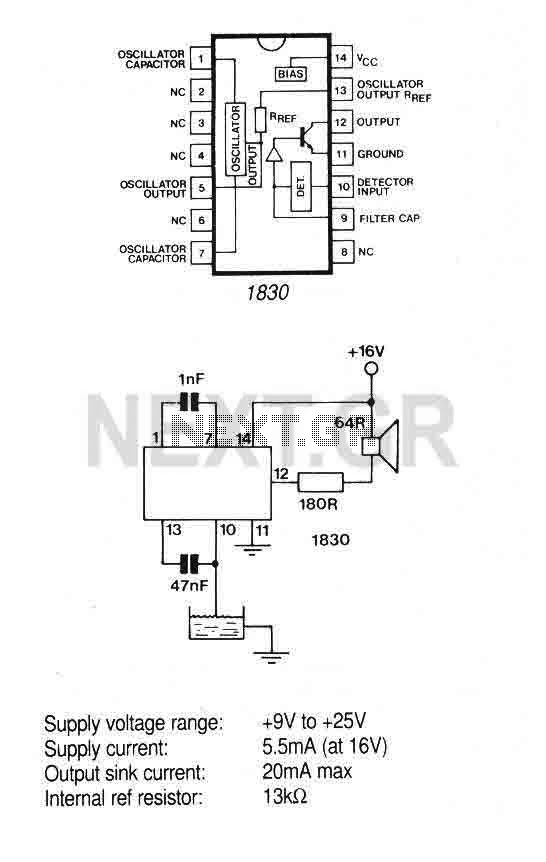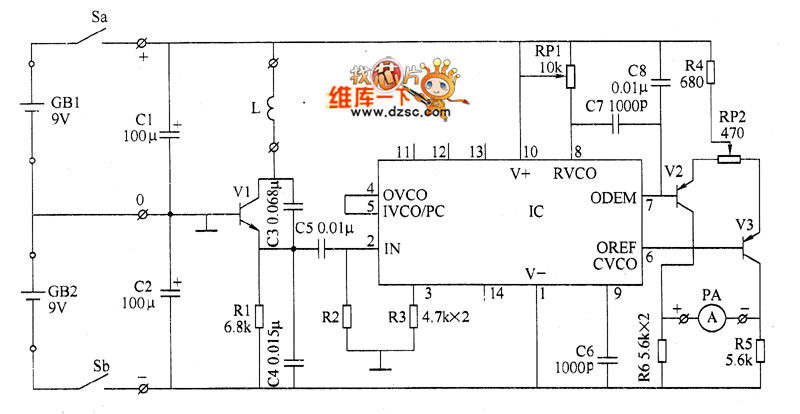
Water Level Detector With Alarm

This is a simple alarm circuit that produces a musical tone when water or any conductive liquid comes into contact with the two sensor wires provided. The circuit utilizes four transistors and one melody generator IC (M3482). When water bridges the sensor wires A and B, the base of transistor Q1 connects to the negative, allowing it to conduct. This action turns on transistors Q2 and Q3. When Q3 is activated, power is supplied to the music generator circuit, which begins producing 12 different melodies sequentially. The music continues as long as water remains between the sensor wires. The potentiometer R12 can be used to control the volume.
The alarm circuit is designed to detect the presence of water or conductive liquids using a pair of sensor wires, which function as a simple switch. The core of the circuit includes four transistors, which serve as amplifiers and switches, and the melody generator IC (M3482), which is responsible for generating sound.
When the sensor wires are dry, Q1 remains off, preventing current flow through Q2 and Q3. However, when a conductive liquid bridges the sensor wires, it creates a path for current to flow, effectively pulling the base of Q1 low. This enables Q1 to conduct, thereby allowing current to flow through Q2 and Q3. The activation of Q3 subsequently powers the melody generator IC, initiating the playback of a series of melodies.
The melody generator IC is capable of producing 12 distinct melodies, which are played in sequence while the sensor wires remain in contact with the conductive liquid. This feature not only provides an auditory alert but can also serve as an effective notification system in various applications, such as water leak detection in homes or industrial settings.
The volume of the sound produced can be adjusted using the potentiometer R12, allowing the user to set the desired loudness of the alarm. This circuit can be powered by a standard DC power supply, and additional components such as resistors and capacitors may be included to stabilize the operation and ensure reliable performance.
Overall, this simple yet effective alarm circuit utilizes basic electronic components to create a functional device capable of alerting users to the presence of water or other conductive liquids, making it a valuable tool for various monitoring applications.This is a simple alarm circuit which produces a musical tone when water or some conducting liquid comes in contact with the two sensor wires provided. The circuit is based on four transistors and one melody generator IC (M 3482). When water comes in contact with the sensors wires A & B, the base of Q1 gets connected with the negative and it conduc
ts. This makes Q2 and Q3 ON. When Q3 is ON the power is available for the music generator circuit and it starts producing 12 different melodies one after another. The music continues as long as there is water between the sensor wires. The POT R12 can be used as a volume controller. 🔗 External reference
The alarm circuit is designed to detect the presence of water or conductive liquids using a pair of sensor wires, which function as a simple switch. The core of the circuit includes four transistors, which serve as amplifiers and switches, and the melody generator IC (M3482), which is responsible for generating sound.
When the sensor wires are dry, Q1 remains off, preventing current flow through Q2 and Q3. However, when a conductive liquid bridges the sensor wires, it creates a path for current to flow, effectively pulling the base of Q1 low. This enables Q1 to conduct, thereby allowing current to flow through Q2 and Q3. The activation of Q3 subsequently powers the melody generator IC, initiating the playback of a series of melodies.
The melody generator IC is capable of producing 12 distinct melodies, which are played in sequence while the sensor wires remain in contact with the conductive liquid. This feature not only provides an auditory alert but can also serve as an effective notification system in various applications, such as water leak detection in homes or industrial settings.
The volume of the sound produced can be adjusted using the potentiometer R12, allowing the user to set the desired loudness of the alarm. This circuit can be powered by a standard DC power supply, and additional components such as resistors and capacitors may be included to stabilize the operation and ensure reliable performance.
Overall, this simple yet effective alarm circuit utilizes basic electronic components to create a functional device capable of alerting users to the presence of water or other conductive liquids, making it a valuable tool for various monitoring applications.This is a simple alarm circuit which produces a musical tone when water or some conducting liquid comes in contact with the two sensor wires provided. The circuit is based on four transistors and one melody generator IC (M 3482). When water comes in contact with the sensors wires A & B, the base of Q1 gets connected with the negative and it conduc
ts. This makes Q2 and Q3 ON. When Q3 is ON the power is available for the music generator circuit and it starts producing 12 different melodies one after another. The music continues as long as there is water between the sensor wires. The POT R12 can be used as a volume controller. 🔗 External reference





